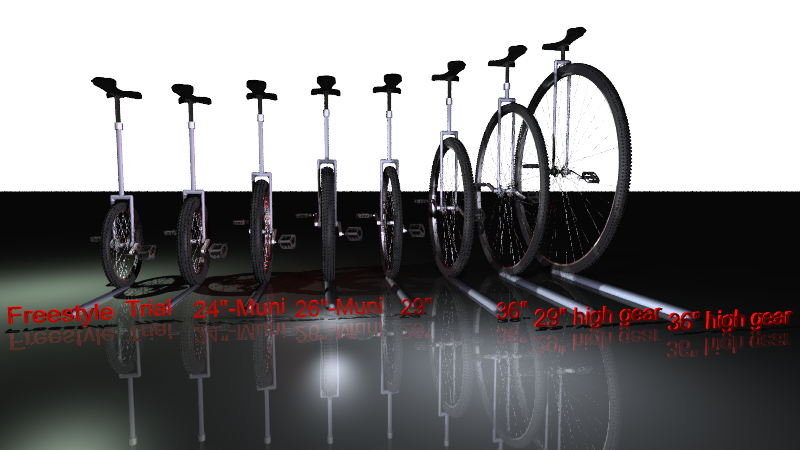
When knowing how fast a unicycle is going, can you determine the speed of other uniycles with different wheel size, crank length, and gear ratio?
Several people have been working on that topic. There was a proposal for Total Gear Ratio (TGR) in the international unicycling forum. According to that concept the riding speed directly depends on wheel size and gear ratio, and reversly depends on crank length. Resulting in the formula
TGR = gear ratio * wheel diameter / crank length.
Double TGR allegedly leads to double speed. It turned out that this assumption does not hold for completely different unicycles. For instance the winning time of the 100m race at 2010 unicycling world championship was 13,09 seconds. So the average speed was 27.5km/h, which means the maximum speed was even higher. According to the rule book a unicycle with wheel diameter 618mm, crank length of 125mm, and direct gearing was used, which has a TGR of 4.9. Following that concept of TGR you would expect a speed of 63km/h for a 36" unicycle with 125mm cranks and 17/11 gearing (like a Schlumpf hub in high gear), which has a TGR of 11.3. That speed yet is way out of scope for any unicyclist.
To improve the concept of Total Gear Ratio there was a discussion titled "Geschwindigkeitsvergleich verschiedener Einräder" ("Comparing the speed of unicycles") in the German unicycle forum which lead to a formula mapping reality very closely. There's no theoretical proof for its correctness. But its accuracy was shown in a series of experiments. For instance the author of this article was riding an 11km roundtrip on 5 different unicycles (wheel sizes from 20" to 36", crank lengths between 110mm and 145mm, with gear box and without). Derivation of resulting times from the calculated values was below 6% in all cases.
The crank lenght's impact on speed turned out to be less than direct. Contrary to that the wheel size has more than direct impact. Probably a consequence of big wheels running smoother. At high speed the rider's physical limits can clearly be observed, partially with respect to air drag. So we introduced a rider dependent power bias which is a speed. The larger it is, the less decay there is, meaning the rider can push the pedals with more power. Experiments showed that the author's power bias has a value of about 10km/h. Most other riders have power biases between 6km/h and 13km/h.
Total Gear Ratio is defined as follows:
TGR = gear ratio * (wheel diameter/mm)6/5 / (crank length/mm)1/2
Dividing by millimeters is required for decoupling lengths from their units. By doing so it is possible to run the exponential function on them. It is possible to work with any unit of lenghts, resulting in different values, but leaving relations as they are.
With given speed1 of unicycle1 with TGR1 the expected speed of unicycle2 will be
speed2 = ln (speed1 * TGR2 / TGR1 / power bias + 1) / ln (speed1 / power bias + 1) * speed1
ln indicates the natural logarithm.
Coming back to the example of a 24" racing unicycle with a speed of 27.5km/h. According to that definition of TGR for a 36" wheel with crank length 125mm and a gearing ratio of 17/11 you will expect a speed of 43km/h. This is a realistic speed that actually is achieved in unicycling races.
In the following picture you see some common unicycles, in order to demonstrate different sizes. The two unicycles at the very right correspond to a 29" unicycle and 36" unicycle with Schlumpf hub in high gear. Length and width of the bars underneath correspond to the respective speed of a unicycle.

Based on a 29" unicycle with 125mm cranks, direct gearing, and a speed of 16km/h which is a realistic commuting speed, the following table lists the expected speeds for a couple of unicycles. Power bias is set to 10km/h. You can see the increasing cadence for smaller wheels and shorter cranks which correlates to reality.
Marked fields can be changed, and you can calculate the results for your own unicycles. Just fill in the parameters and press Calculate. It is also possible to leave fields empty in line Your unicycle in order to derive these values. So for instance you can retrieve the required crank length for known wheel diameter, gear ratio, and speed.